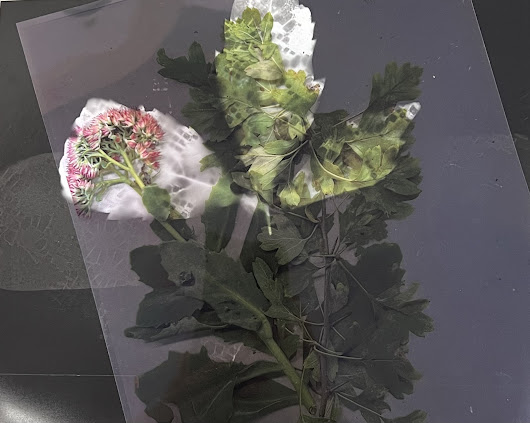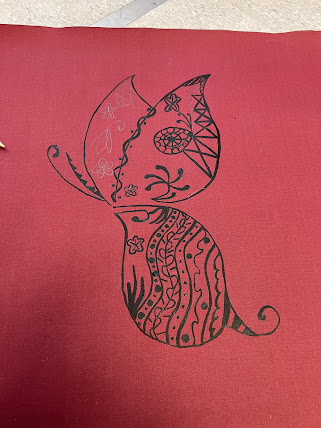During this term, while following up with the Lace Project at Newstead Abbey, we began to create our own works with inspiration from lace and its different types.I wanted to have the topic of lace fresh inside my mind so I searched up different types of lace that I could use, or, get inspiration to base it from, and upon searching around this topic, I came across a bobbin lace artist from China, JiaYue. Since that I am very interested in the different cultures of Asia, such as art, architecture and lifestyle, I decided to go with this theme.
JiaYue, who lives in China, could not learn about bobbin lace, only a part from the internet. But soon she went to Shandong, 2000km away from Chengdu, and found a teacher, Wang Jiaqing, who had been making lace for the past 57 years (as of 2021), that was wiling to teach her. Thus soon developed JiaYue's skills with the materials, so she went on to create really intricate works.
Pieces of JiaYun’s works and collaborations, along with my inspirations can be found here.
"I haven't designed any patterns all by myself, but I want to make Bobbin Lace with different materials in the future. I want to combine lace with a variety of interesting things. The theme will be about light & shadow, ballet, jellyfish, leaves, flowers, and Chinese pane."
JiaYue's desires to use different types of materials in the future has inspired me to create my works with different types of materials too, from papers to fabrics.
Looking at historic Chinese art, I feel that my works have also been inspired by a hanging scroll Chinese ink wash painting by Ma Ling in the 13th century. Painting in the traditional style is known today in Chinese as 'guó huà,' meaning "national painting" or "native painting," as opposed to Western styles of art which became popular in China in the 20th century. The finished work can be mounted on scrolls, such as hanging scrolls or handscrolls. Traditional painting can also be done on album sheets, walls, lacquerware, folding screens, and other media.
Our work at Newstead Abbey can inspired this as we had experimented with some cyanotypes, I utilised some lace as well as some foliage that I had found on our tour, I had layered them to the point that only a certain part of foliage was clearly visible, but the lace too, so that made in look like a laced leaf, thus inspiring my final works.
___________________________________________________
(start of version 1)
I first experimented with an A3 piece of paper to start with, where I would soon start to make similar pieces, just bigger sizes.
At the start of this piece, I drew out the outline of the butterfly first before painting part of the page red so that it would be easier for me to outline the lines without having to paint the white spaces, thus making it harder for myself. Before using black paint to outline the shapes, I drew in some shapes and some lace patterns with some inspiration from Chinese lace. On some areas, I used small white details so that the patterns would stand out.
(finished version 1)
After the completion of the first image, I wanted to take it further by changing some things and adding some layering of prints from actual pieces of lace. I inverted the colours so that the background would be black instead of red, and vice versa. The lace prints I added were also in red, but if I was to do this piece again, I would practice printing the lace on first so that I can get more of a bold shape from them, as well as having the white patterns a darker shade so that it doesn't stand out as much as it does and not seem so bright, as well as try it on another material, such as wood or a metallic surface.
(version 2)
By this time, I knew that I has to work on an even bigger scale, to capture more detail into it, as working on a smaller surface, you won't be able to capture such detail. But just like the first piece, I drew on some patterns first before painting the outlines. I also avoided using the colour white as I thought that it would be too bright and would distract the viewer(s) from from the details.
(process of version 3)
Soon enough, I decided that I should move on from paint and try another material. So I tried digital, as in my spare time I like to draw and practice my skills digitally, on my iPad using Procreate.
Staying with the same techniques as my other pieces, I used different shades of red instead of black.
Throughout all of my works, I used the colour red, which 'is a popular colour in Chinese culture, symbolising luck, joy, and happiness. It also represents celebration, vitality and fertility in traditional Chinese colour symbolism.'
(version 4)
My main inspiration for these pieces are from my favourite video game, created by a Chinese company in Shanghai, Genshin Impact. The game consists of 7 nations, each nation and character has a different element that they possess, and each nation is based from real life architecture and places in the world. Each character in the game has their own constellation, and this one is called Papilla Charontis, which means, in Latin, 'Butterfly of Charon,' which references an extinct butterfly and Greek mythos' Charon: ferrymen that carried souls of the newly-deceased across the river Styx, which runs through the border of the living and the dead. "Each nation takes inspiration from real-life nations and cultures: "Mondstadt" is German for "moon city", and takes inspiration from medieval Western Germany; Liyue (璃月, Jade Moon) is based on China; Inazuma (稲妻, lightning) is based on Japan; Sumeru, named after Mount Meru, takes inspiration from North Africa, West and South Asia; Fontaine, (French for "Fountain") is based on France; Natlan is based on Indigenous America, Latin America and West African Cultures; and Snezhnaya (Снежная, snowy) takes inspiration from Russia." - Wiki page.
The butterfly inspiration for my pieces are based from a character from the city Liyue, which is based from China. The characters name is Hu Tao ("who-towe"), and she is a funeral director, helping people get to the afterlife, and in China, butterflies are seen as a symbol or rebirth after death, because when one butterfly dies, it becomes two, it means that the deceased person is reborn into another life. Hu Tao's element is pyro (which is fire), and in China, fire means "summer and enthusiasm; nature at its peak of growth, and warmth in human relationships," which matches with her warm and sometimes bubbly personality.
Before this I had experimented with other materials, such as Lino, where I carved out an image before rolling on some ink and then pressing it onto card, where it would create an image. This inspired my main project from the game, apart from that this is from another characters constellation, with it being called Dracaena Somnolenta, which means 'sleeping serpent' in Japanese, as the place where this character is from, Inazuma, is based on Japan. I had experimented with the use of colours before settling on the colour blue as the characters element is hydro (water), and the serpent appears underwater in-game.
In the Japanese culture, water symbolises purification and life. Without water, there would be no life. One belief is that waterfalls are sacred and standing under them is considered purifying.
(processes of these works to the final version)

















No comments:
Post a Comment